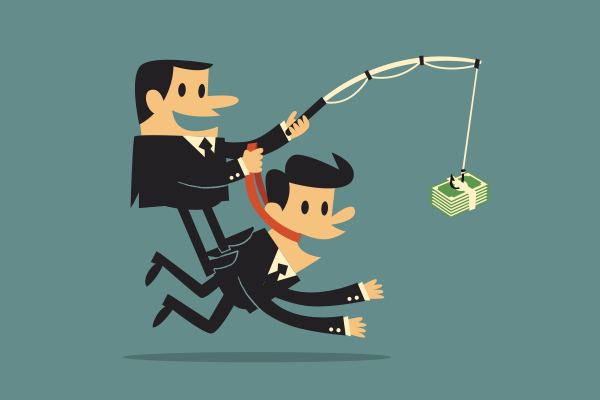Control by human resourses in an enterprise is a complex science. The success of the entire company depends on how well it is mastered by the management team. The times of slavery, when the main goal was to force workers to fulfill their duties, remained in the distant past. Today, all managers strive to organize the productive activities of their subordinates at their own request. And this means that the staff should be carried away by the work process, develop each employee's personal interest in the success of the organization. What types of staff motivation are used today, do they all really work in practice?
What is motivation?
 Motivation is the basis of all activities, except those that are based on unconditioned reflexes. The term “motive” in modern psychology means something that predetermines human behavior and actions. Note: notice the difference between this definition and the everyday meaning of the word. In a commonly used context, a motive is an explanation of a person’s actions, the reason why he committed a certain act. Accordingly, motivation in management is the awakening of the aspirations and desires of the object and the creation of an environment in which the employee will become more productive to work for a certain personal benefit. There is also a related concept of manipulation. In this case, we are talking about a hidden effect on a person, prompting him to perform certain actions beneficial to the manipulator. So, after understanding the basic concepts, we can consider in detail the types of staff motivation.
Motivation is the basis of all activities, except those that are based on unconditioned reflexes. The term “motive” in modern psychology means something that predetermines human behavior and actions. Note: notice the difference between this definition and the everyday meaning of the word. In a commonly used context, a motive is an explanation of a person’s actions, the reason why he committed a certain act. Accordingly, motivation in management is the awakening of the aspirations and desires of the object and the creation of an environment in which the employee will become more productive to work for a certain personal benefit. There is also a related concept of manipulation. In this case, we are talking about a hidden effect on a person, prompting him to perform certain actions beneficial to the manipulator. So, after understanding the basic concepts, we can consider in detail the types of staff motivation.
External and internal motivation
The most common external motivation. Its mechanism is extremely simple: the manager gives the assignment to the employee and personally chooses the method of promotion, as well as immediately voices it. This may be a bonus for timely and high-quality performance of work, promotion or just moral praise / extra day off. Accordingly, the employee, along with the task, receives personal interest in its implementation, and throughout the process he knows exactly what he is working for. An entirely different matter is intrinsic motivation. In this case, the manager will have to do more extensive work, since its ultimate goal is to develop important professional qualities in the staff and reduce the value of the negative aspects of the work process. Usually these types of motivation are used simultaneously.
What determines the interest of a specialist in their work?
 Internal motivation largely depends on the specifics of the work itself. If a profession allows a person to develop, learn something new, and the work process provides great scope for the realization of creative abilities and gaining self-satisfaction, a specialist will most likely be interested in his work. Motivation of personnel in the enterprise today is carried out by various methods. These are employee reward and punishment systems, upbringing, explanations and personal example. Often, types of motivation, when considered individually, are also called motivators. It is important to understand that this term refers to any one method of exposure.
Internal motivation largely depends on the specifics of the work itself. If a profession allows a person to develop, learn something new, and the work process provides great scope for the realization of creative abilities and gaining self-satisfaction, a specialist will most likely be interested in his work. Motivation of personnel in the enterprise today is carried out by various methods. These are employee reward and punishment systems, upbringing, explanations and personal example. Often, types of motivation, when considered individually, are also called motivators. It is important to understand that this term refers to any one method of exposure.
Motivation, types of motives and motivators.
 In recent years, specialists around the world have been trying to classify the principles of personnel management, create a unified system and determine which of them are most effective. In fairness, it should be noted that one and the same motivator can act on a certain person in certain conditions and not have any effect on another in other circumstances.From all this we can make a logical conclusion: there is no universal formula for success, motivation tools should be selected for a particular company, and often for specific employees individually. Sometimes, even an experienced leader must change tactics in the process and introduce new motivators if the previous ones did not help to achieve the desired result.
In recent years, specialists around the world have been trying to classify the principles of personnel management, create a unified system and determine which of them are most effective. In fairness, it should be noted that one and the same motivator can act on a certain person in certain conditions and not have any effect on another in other circumstances.From all this we can make a logical conclusion: there is no universal formula for success, motivation tools should be selected for a particular company, and often for specific employees individually. Sometimes, even an experienced leader must change tactics in the process and introduce new motivators if the previous ones did not help to achieve the desired result.
Motivation in Russian
 Studies show that in Russia one of the most effective motivators is material incentives for successfully completed work. The most commonly used types of labor motivation in our country are by status and by result. Accordingly, in the first case, the entire department is rewarded for the successful completion of the work, and the size of the rewards is individually determined by the qualifications of the particular employee and the position held by him. In situations where you can accurately determine the productivity of each employee in a group of people, it is appropriate to use the motivation for the result. In this case, employees who have shown the best results receive maximum encouragement. The choice of types of motivation directly depends on the internal structure of the company, relationships in the team, corporate hierarchy and management principles used.
Studies show that in Russia one of the most effective motivators is material incentives for successfully completed work. The most commonly used types of labor motivation in our country are by status and by result. Accordingly, in the first case, the entire department is rewarded for the successful completion of the work, and the size of the rewards is individually determined by the qualifications of the particular employee and the position held by him. In situations where you can accurately determine the productivity of each employee in a group of people, it is appropriate to use the motivation for the result. In this case, employees who have shown the best results receive maximum encouragement. The choice of types of motivation directly depends on the internal structure of the company, relationships in the team, corporate hierarchy and management principles used.
Theories and systems of personnel motivation
There are a large number of teachings and patented theories that explain the types of motivation of activities, the mechanisms of successful impact on staff and offer ready-made classifications. They are based on the principle of considering the processes of workers' activities at psychological and physiological levels. Of great popularity, for example, is a complex procedural theory, in which justice and expectation occupy a significant place. In this concept, the effectiveness of motivation is based on the interaction of the following factors: perception, effort, results, encouragement and degree of satisfaction. Motivation will be successful only if the promised remuneration is consistent with the efforts made. It is important for each employee after fulfilling their obligations to receive satisfaction from the reward that relies on it.
Theories of needs
 Great respect and authority enjoys the theory of significance of the needs of A. Maslow. The author offers us a detailed classification in which the needs are described according to the degree of importance for a person. Based on this list, you can develop an individual motivation system for a particular employee. So, in the first place are physiological needs, then security needs, belonging to a certain social group, respect for others and personal self-satisfaction. Moreover, the author of the theory says that each individual strives to satisfy his needs strictly in the order of their importance. A slightly different classification of human needs is suggested by David McClelland. This researcher suggests examining in detail the person’s desire to gain power and success.
Great respect and authority enjoys the theory of significance of the needs of A. Maslow. The author offers us a detailed classification in which the needs are described according to the degree of importance for a person. Based on this list, you can develop an individual motivation system for a particular employee. So, in the first place are physiological needs, then security needs, belonging to a certain social group, respect for others and personal self-satisfaction. Moreover, the author of the theory says that each individual strives to satisfy his needs strictly in the order of their importance. A slightly different classification of human needs is suggested by David McClelland. This researcher suggests examining in detail the person’s desire to gain power and success.
Effective Motivation Rules for Leaders
 It is impossible to effectively manage personnel without knowing the theory and basic principles of exposure. We examined in detail the concept and types of motivation. This knowledge is necessary for each leader. The development of corporate culture is also of great importance.
It is impossible to effectively manage personnel without knowing the theory and basic principles of exposure. We examined in detail the concept and types of motivation. This knowledge is necessary for each leader. The development of corporate culture is also of great importance.
Remember: even time-tested and many managers motivators will not work in an organization where the authority of the leadership is undermined. The leader should select incentives that are appropriate to the requirements and responsibilities. The fulfillment of promises in full is also important.
Remember: it is enough to “forget” or not fulfill your obligations to the full once, and in the future you can forget about the effective use of motivation. After such an incident, workers will be disappointed and unlikely to want to work productively.If the leadership will responsibly and honestly fulfill its obligations, any kind of motivation can be used, and most of them will meet expectations.
